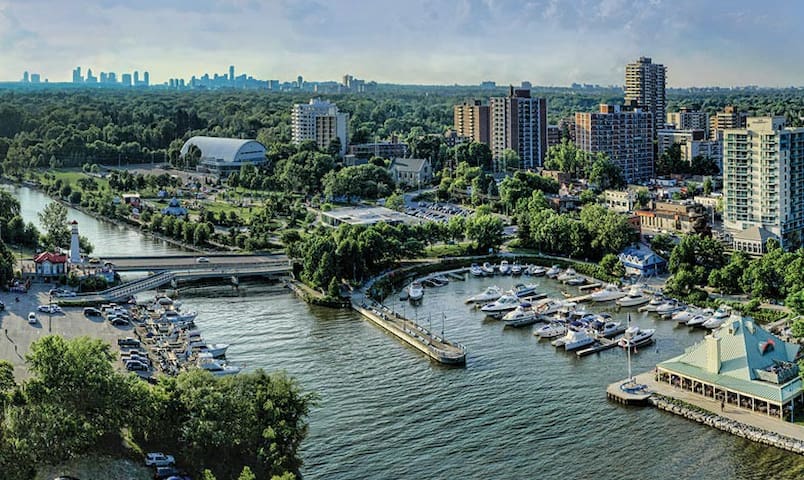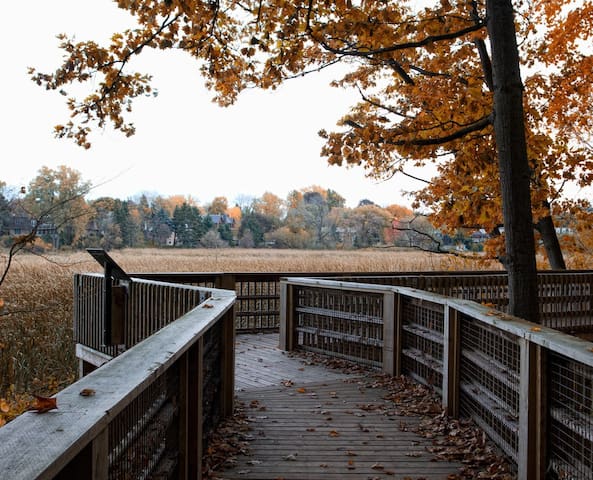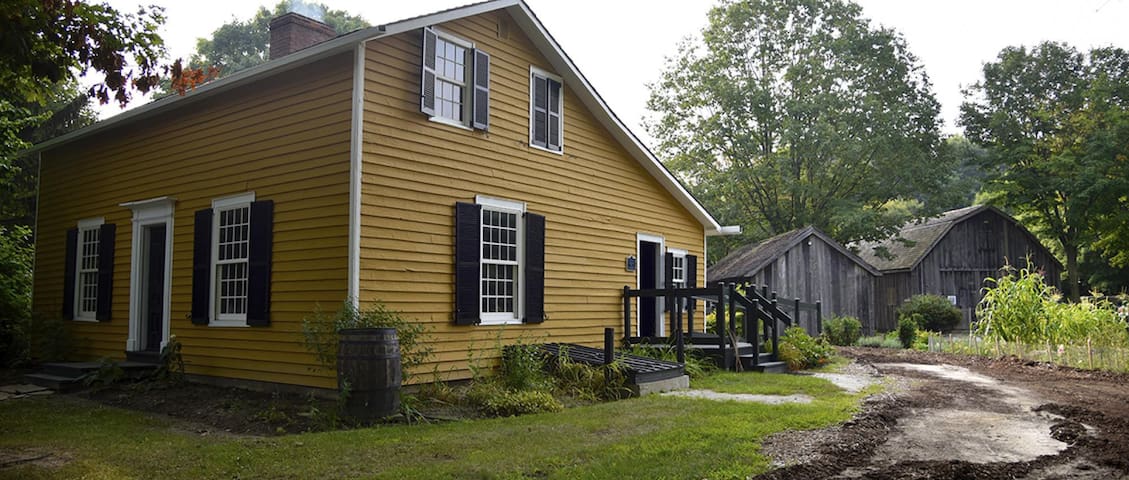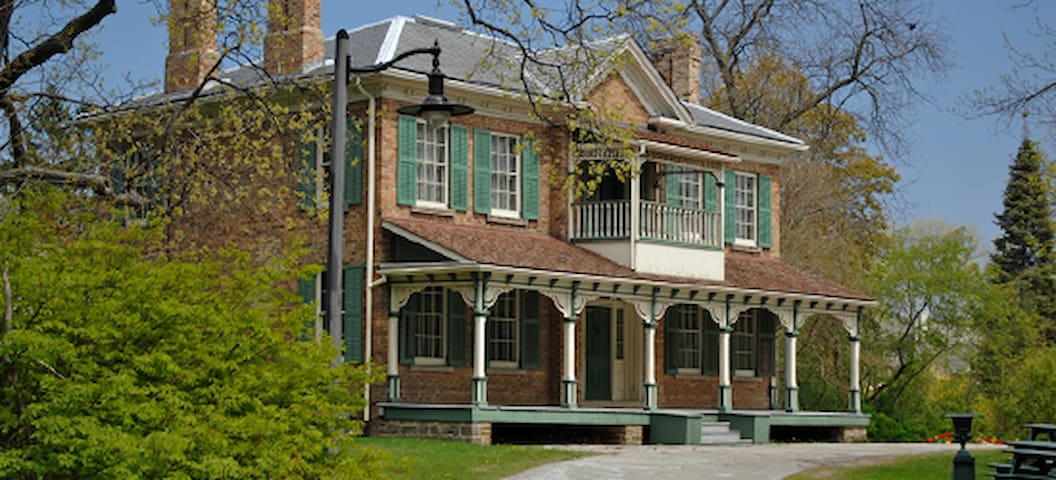Neighborhoods
This house is located in Clarkson Village. Port Credit is our neighbouring neighbourhood in 10 minute driving distance. Find out more information about these two attractions here.
Clarkson Village, is a neighbourhood in the southwest corner of the city of Mississauga, along the shore of Lake Ontario.
In 1808, Warren and Joshua Clarkson immigrated to this area. They stayed here, worked hard and built a home here. They started farming in this area and built the community's first store along the stagecoach trail. Soon after, they opened a post office and asked for a train station to export their strawberries.
Clarkson is home to both of the City of Mississauga's historic museums: Bradley Museum and Benares House.
The Bradley Museum provides a window into the everyday life of early settlers in Ontario, and hosts Sunday teas, rotating exhibits, and special events. The museum grounds include the original farmhouse built in 1830.
Benares House, located on the border between Clarkson and the neighbouring community of Lorne Park, was inhabited by four generations of the Harris and Sayers families. Rumored to be the inspiration for Canadian author Mazo de la Roche's famous "Whiteoak Chronicles" (or "Jalna series") novels.
The area has a lot of bars and restaurants as well as cozy small shops which still gives you the feeling of a village. Pure nature is accessible in walking distance (Rattray Marsh Conservation Area) Commute to Toronto and Niagara Falls is super fast and easy thanks to Clarkson GO Station.
Clarkson
Clarkson Village, is a neighbourhood in the southwest corner of the city of Mississauga, along the shore of Lake Ontario.
In 1808, Warren and Joshua Clarkson immigrated to this area. They stayed here, worked hard and built a home here. They started farming in this area and built the community's first store along the stagecoach trail. Soon after, they opened a post office and asked for a train station to export their strawberries.
Clarkson is home to both of the City of Mississauga's historic museums: Bradley Museum and Benares House.
The Bradley Museum provides a window into the everyday life of early settlers in Ontario, and hosts Sunday teas, rotating exhibits, and special events. The museum grounds include the original farmhouse built in 1830.
Benares House, located on the border between Clarkson and the neighbouring community of Lorne Park, was inhabited by four generations of the Harris and Sayers families. Rumored to be the inspiration for Canadian author Mazo de la Roche's famous "Whiteoak Chronicles" (or "Jalna series") novels.
The area has a lot of bars and restaurants as well as cozy small shops which still gives you the feeling of a village. Pure nature is accessible in walking distance (Rattray Marsh Conservation Area) Commute to Toronto and Niagara Falls is super fast and easy thanks to Clarkson GO Station.
Port Credit is a great walking destination with hundreds of bars and restaurants and beautiful harbour to enjoy walking, kayaking or fishing.
The location of Port Credit was in the 1700s, the land of the Mississauga Ojibwe band. The location became used as a meeting place between the band and write traders, and the river was known to them as the Missinhe or "trusting creek". To the French and later the English the mouth was known as "Port Credit" and a trading post was established in 1720, where goods were traded or bought on credit. The earliest reference is on a map drawn in 1757 by La Broquerie.
The first permanent structure built by the English at the site was the Government Inn (1798–1861), on the east bank of the river. Lieutenant Governor John Graves Simcoe had ordered construction of the Inn to serve as a way station for travellers by land and lake, and it was leased to a succession of residents until its destruction by fire.
In 1805, the Mississauga gave up much of the surrounding lands, but retained the Credit River, which they held in esteem as the favourite resort of their ancestors. After the War of 1812, the numbers of Mississauga dwindled and they gave up their lands except for a reserve at the mouth, believing the King would protect the land for them in the face of settler encroachment.[1]
Outside the reserve, a village plan was laid out in 1834 and for several years, Port Credit was a thriving harbour community used by the natives and settlers jointly. Village lots were sold to settlers by the natives and the Port Credit Harbour Company, which developed the harbour, was jointly owned. The harbour was a working fishing port and a regional trading centre for grain and other agricultural products. A lighthouse was in use from 1882 to 1918 and remained standing until destroyed by fire in 1936
148 íbúar mæla með
Port Credit
Port Credit is a great walking destination with hundreds of bars and restaurants and beautiful harbour to enjoy walking, kayaking or fishing.
The location of Port Credit was in the 1700s, the land of the Mississauga Ojibwe band. The location became used as a meeting place between the band and write traders, and the river was known to them as the Missinhe or "trusting creek". To the French and later the English the mouth was known as "Port Credit" and a trading post was established in 1720, where goods were traded or bought on credit. The earliest reference is on a map drawn in 1757 by La Broquerie.
The first permanent structure built by the English at the site was the Government Inn (1798–1861), on the east bank of the river. Lieutenant Governor John Graves Simcoe had ordered construction of the Inn to serve as a way station for travellers by land and lake, and it was leased to a succession of residents until its destruction by fire.
In 1805, the Mississauga gave up much of the surrounding lands, but retained the Credit River, which they held in esteem as the favourite resort of their ancestors. After the War of 1812, the numbers of Mississauga dwindled and they gave up their lands except for a reserve at the mouth, believing the King would protect the land for them in the face of settler encroachment.[1]
Outside the reserve, a village plan was laid out in 1834 and for several years, Port Credit was a thriving harbour community used by the natives and settlers jointly. Village lots were sold to settlers by the natives and the Port Credit Harbour Company, which developed the harbour, was jointly owned. The harbour was a working fishing port and a regional trading centre for grain and other agricultural products. A lighthouse was in use from 1882 to 1918 and remained standing until destroyed by fire in 1936
Sightseeing
in a 5 minute driving, 15 min walking distance, you will reach a unique conservation area to visit. Rattray Marsh is an “environmental gem” located in a unique natural setting within Clarkson Village in the City of Mississauga. As the last remaining lakefront marsh between Toronto and Burlington, this environmentally sensitive wetland offers a different experience for nature lovers. Rattray Marsh is home to a variety of wildlife and plants and a definite must see for avid bird watchers, photographers and nature lovers.
24 íbúar mæla með
Rattray Marsh varðandi svæði
1180 Lakeshore Rd Win a 5 minute driving, 15 min walking distance, you will reach a unique conservation area to visit. Rattray Marsh is an “environmental gem” located in a unique natural setting within Clarkson Village in the City of Mississauga. As the last remaining lakefront marsh between Toronto and Burlington, this environmentally sensitive wetland offers a different experience for nature lovers. Rattray Marsh is home to a variety of wildlife and plants and a definite must see for avid bird watchers, photographers and nature lovers.
Museums
Clarkson is home to both of the City of Mississauga's historic museums: Bradley Museum and Benares House.
In your 15 minute walking distance, the two-acre Bradley Museum is located on the edge of Lake Ontario, nestled in a 70-year old maple grove. The site has accessible nature trails, connects to the Waterfront Bike Trail and is within walking distance of the Rattray Marsh. The Bradley Museum complex consists of four buildings, all designated Ontario Heritage sites:
1. The Anchorage, an Ontario Regency style cottage from the early nineteenth century;
2. The Bradley House, a two-story saltbox-style farmhouse from 1830;
3. a restored Port Credit log cabin from the early 1800s;
4. barn from the turn of the last century.
13 íbúar mæla með
Bradley Museum
1620 Orr RdIn your 15 minute walking distance, the two-acre Bradley Museum is located on the edge of Lake Ontario, nestled in a 70-year old maple grove. The site has accessible nature trails, connects to the Waterfront Bike Trail and is within walking distance of the Rattray Marsh. The Bradley Museum complex consists of four buildings, all designated Ontario Heritage sites:
1. The Anchorage, an Ontario Regency style cottage from the early nineteenth century;
2. The Bradley House, a two-story saltbox-style farmhouse from 1830;
3. a restored Port Credit log cabin from the early 1800s;
4. barn from the turn of the last century.
- In 5 minutes driving ( or 30 minutes walking distance)
With more than 165 years of history, this exquisite Georgian style estate was home to four generations of the Harris and Sayers families. Noted for its quiet presence in a picturesque park-like setting - Benares is filled top to bottom with original family possessions spanning 4 generations. Part of what makes Benares so unique is that more than 95% of the artifacts in the house are original to the Harris family and this home. Benares and most of its contents were donated by the three great grandchildren of Captain Harris -- Geoffrey Harris Sayers, Dora Sayers Caro and Barbara Sayers Larson. It was restored and fully furnished with Harris Family items and opened to the public as Mississauga's newest museum in 1995.
The Visitor Centre at Benares hosts an interpretive gallery about Benares Historic House and its original residents; it also includes an Exhibition Gallery with rotating exhibitions and displays.
10 íbúar mæla með
Benares Historic House
1507 Clarkson Rd N - In 5 minutes driving ( or 30 minutes walking distance)
With more than 165 years of history, this exquisite Georgian style estate was home to four generations of the Harris and Sayers families. Noted for its quiet presence in a picturesque park-like setting - Benares is filled top to bottom with original family possessions spanning 4 generations. Part of what makes Benares so unique is that more than 95% of the artifacts in the house are original to the Harris family and this home. Benares and most of its contents were donated by the three great grandchildren of Captain Harris -- Geoffrey Harris Sayers, Dora Sayers Caro and Barbara Sayers Larson. It was restored and fully furnished with Harris Family items and opened to the public as Mississauga's newest museum in 1995.
The Visitor Centre at Benares hosts an interpretive gallery about Benares Historic House and its original residents; it also includes an Exhibition Gallery with rotating exhibitions and displays.





